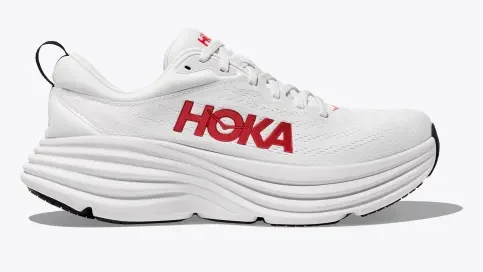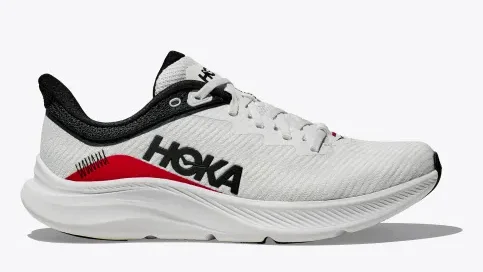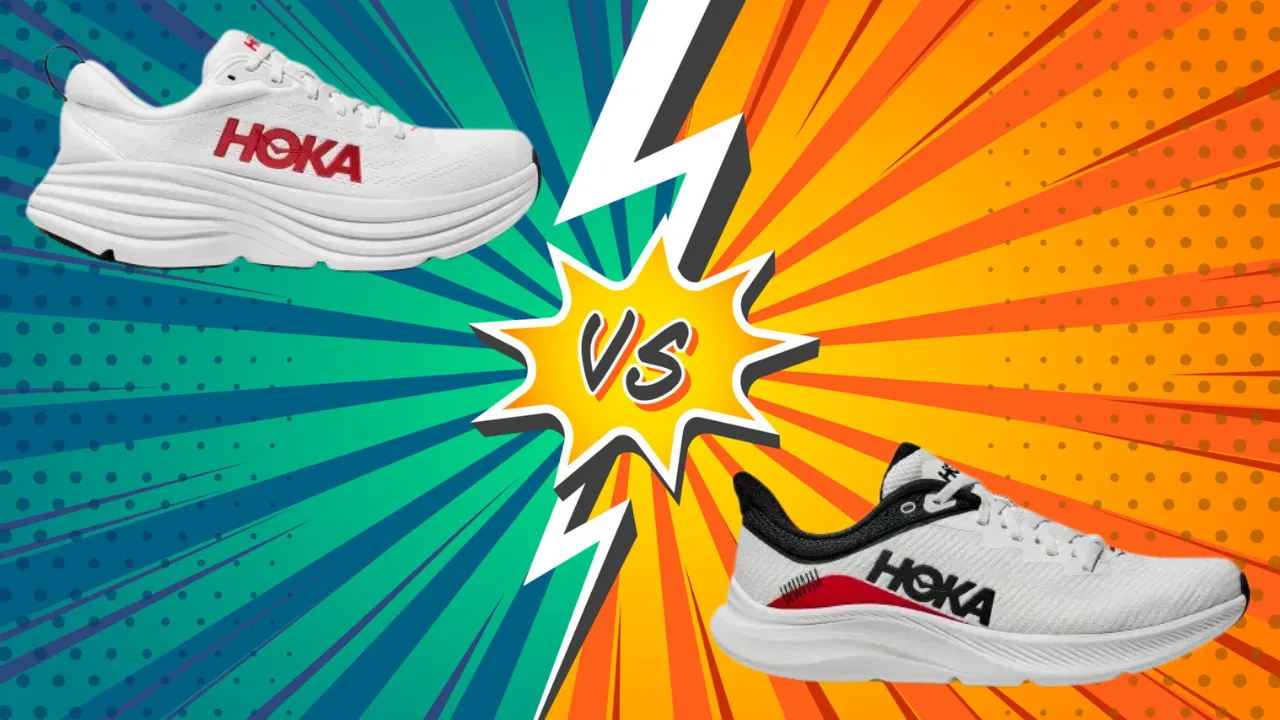Lace up, running enthusiasts! We’re diving into a head-to-head showdown between two popular Hoka models: the cushion-packed Bondi 8 and the nimble Solimar.
Whether you’re a seasoned marathoner or just starting your running journey, choosing the right shoe can make or break your experience. Let’s unpack the features, put these shoes through their paces, and help you find your perfect match. Ready, set, let’s run!
key takeaways:
- The Hoka Bondi 8 excels in maximum cushioning and comfort, making it ideal for long-distance runs and all-day wear. It’s particularly suited for those needing extra support or dealing with foot issues.
- The Hoka Solimar offers a more versatile, balanced ride with responsive cushioning. It’s lighter and more adaptable to various running paces, making it a great all-rounder for different types of workouts.
- For walking and standing all day, the Bondi 8 takes the lead with its plush comfort and stable base. However, the Solimar offers a more natural feel and might be preferred for active walking.
- Both shoes incorporate recycled materials, reflecting Hoka’s commitment to sustainability. The Solimar uses a higher percentage of recycled content in its upper construction.
- Price-wise, the Bondi 8 is more expensive but offers maximum features for long-distance comfort. The Solimar provides excellent value as a versatile, more budget-friendly option for various running needs.
Comparison Table between Hoka Bondi 8 And Hoka Solimar:
| Feature | Hoka Bondi 8 | Hoka Solimar |
|---|---|---|
| Launched In | 2022 | 2023 |
| Stability | Neutral to Moderate | Neutral |
| Flexibility | Moderate | Higher |
| Sizing | True to size | True to size |
| Weight | 10.80 oz | 8.50 oz |
| Cushion | Plush | Balanced |
| Outsole | Durabrasion rubber | High abrasion rubber |
| Midsole | Lightweight, resilient foam | Compression-molded EVA foam |
| Upper | Engineered mesh with 50% recycled polyester | Stretchy, recycled content mesh (88% recycled polyester) |
| Retail Price | $165 | $125 |
Hoka Bondi 8 VS Hoka Solimar: Features Comparision
1) Materials: outsole, insole, upper sole
The Bondi 8 and Solimar showcase Hoka’s commitment to quality materials with some key differences. The Bondi 8 features a Durabrasion rubber outsole, designed for durability and traction. Its insole boasts an Ortholite® hybrid sockliner for premium comfort, while the upper utilizes an engineered mesh with 50% recycled polyester.


In contrast, the Solimar employs a high abrasion rubber outsole for long-lasting wear. Its insole consists of a molded EVA sockliner, and the upper is constructed with a stretchy, recycled content mesh containing 88% recycled polyester.
Both models incorporate recycled materials, reflecting Hoka’s eco-conscious approach. The Bondi 8’s materials lean towards maximum cushioning, while the Solimar’s choices prioritize a balance of comfort and responsiveness.
2) Durability
When it comes to durability, both shoes are built to last, but with different strengths. The Bondi 8’s Durabrasion rubber outsole and zonal rubber placement are strategically designed for weight savings while maintaining longevity in high-wear areas. Its robust construction and plush cushioning suggest it may hold up well for heavier runners or those putting in serious mileage.
The Solimar, with its high abrasion rubber outsole, is also engineered for durability, particularly in high-sweat areas. Its lighter construction might make it less durable for very heavy use compared to the Bondi 8, but it should still offer excellent longevity for most runners. Both shoes use quality materials in their uppers, with the Solimar’s stretchy mesh potentially adapting better to foot movement over time.
3) Fit
The fit of these two models caters to different preferences. The Bondi 8 offers a roomy fit, especially in the toe box, making it ideal for runners with wider feet or those who prefer some extra space. Its partially gusseted tongue and memory foam collar work together to provide a secure, comfortable fit around the midfoot and ankle.


The Solimar, being a more streamlined shoe, offers a snugger fit overall. Its anatomical Achilles construction is designed to hug the heel and provide support, while the stretchy upper mesh adapts to the foot’s shape.
Both shoes are true to size, but the Bondi 8 might feel more accommodating for those needing extra width, while the Solimar could be preferable for runners seeking a more locked-in feel.
4) Cushioning
Cushioning is where these shoes truly differentiate themselves. The Bondi 8 is all about maximum cushioning, featuring Hoka’s plushest setup. Its lightweight, resilient foam midsole provides a soft, bouncy feel underfoot, ideal for those seeking impact absorption and comfort over long distances. The extended heel and brand-new foam in this iteration amplify the cushioning effect.
On the other hand, the Solimar offers a more balanced cushioning approach. Its compression-molded EVA foam midsole is designed to provide protective cushion while maintaining responsiveness.
This makes the Solimar more versatile, offering enough cushion for comfort but still allowing for faster-paced runs when needed. The choice between the two largely depends on whether you prioritize maximum shock absorption (Bondi 8) or a more responsive ride (Solimar).
5) Stability
While both shoes are classified as neutral, they offer different levels of stability. The Bondi 8 provides a neutral to moderate stability profile. Its wide base and substantial cushioning create an inherently stable platform, even without additional stability features. The extended heel design enhances this effect, potentially benefiting heel strikers or those needing extra support during foot strike.
The Solimar, while also neutral, offers a different kind of stability. Its lower stack height and more balanced cushioning provide a closer-to-ground feel, which some runners find more stable.
The Solimar’s late stage Meta-Rocker™ technology aids in providing a smooth, stable transition through toe-off. For runners seeking maximum stability, the Bondi 8 might edge out, but those preferring a more natural, ground-connected stability might lean towards the Solimar.
6) Value For Money
When it comes to value for money, both shoes offer compelling propositions. The Bondi 8, priced at $165, justifies its higher cost with maximum cushioning, durability, and all-day comfort. It’s an investment for serious runners or those with joint issues.
The Solimar, at $125, provides excellent value with its versatile performance and eco-friendly materials. It’s a more budget-friendly option that doesn’t compromise on quality, making it ideal for runners seeking a do-it-all shoe without breaking the bank.
Hoka Bondi 8 VS Hoka Solimar: Performance Testing
1) For Walking
When it comes to walking, both shoes excel but in different ways. The Bondi 8, with its maximum cushioning and plush feel, offers supreme comfort for long walks or all-day wear.
Its wide base and stable platform provide excellent support, reducing fatigue even after hours on your feet. The memory foam collar adds to the overall comfort, cradling the ankle during extended periods of walking.
The Solimar, while less cushioned, offers a more responsive walking experience. Its balanced cushioning and lower stack height provide a natural gait cycle, which some walkers might prefer.
The Solimar’s lighter weight could be advantageous for those taking quicker walks or transitioning between walking and light jogging. For pure walking comfort, especially for those with joint issues, the Bondi 8 takes the lead, but the Solimar offers a more versatile, natural-feeling option for active walkers.
2) For Running
In the running department, these shoes cater to different preferences and running styles. The Bondi 8, true to its design, shines in long-distance, easy-paced runs.
Its substantial cushioning and shock absorption make it ideal for recovery runs or when you’re logging serious mileage. The extended heel design promotes a smooth heel-to-toe transition, beneficial for heel strikers. However, its weight might be a drawback for speed work.
The Solimar, with its more balanced cushioning and lighter weight, offers greater versatility in running. It’s suitable for both easy runs and tempo sessions, thanks to its responsive midsole and late stage Meta-Rocker™.
The Solimar’s design allows for a quicker turnover, making it more suitable for faster-paced runs or interval training. For pure comfort in long, slow runs, the Bondi 8 excels, but for a shoe that can handle various running paces and distances, the Solimar proves more adaptable.
3) For Standing All Day
When it comes to standing all day, comfort and support are paramount, and both shoes deliver, albeit differently. The Bondi 8 is a standout performer in this category.
Its maximum cushioning and plush feel provide excellent shock absorption, reducing fatigue even after hours of standing. The wide, stable base offers steady support, while the Ortholite® hybrid sockliner adds an extra layer of comfort.
For professions requiring long periods of standing, like healthcare or retail, the Bondi 8 could be a game-changer. The Solimar, while not as cushioned, still performs admirably. Its balanced cushioning and lighter weight might be preferred by those who need to transition frequently between standing and walking.
The anatomical Achilles construction provides good heel support during prolonged standing. While both are suitable, for pure standing comfort, especially on hard surfaces, the Bondi 8 edges out the Solimar.
4) For Plantar Fasciitis
For runners dealing with plantar fasciitis, both shoes offer features that can help, but in different ways. The Bondi 8, with its maximum cushioning and plush feel, provides excellent shock absorption that can reduce stress on the plantar fascia. Its wide base and stable platform offer good support, which is crucial for managing this condition.
The memory foam collar adds extra comfort around the ankle, potentially reducing overall foot strain. The Solimar, while less cushioned, offers features that could benefit plantar fasciitis sufferers. Its balanced cushioning and late stage Meta-Rocker™ promote a natural gait cycle, which can help distribute pressure more evenly across the foot.
The anatomical Achilles construction provides good heel support, another key factor in managing plantar fasciitis. While the Bondi 8 might be the safer choice for severe cases due to its maximum cushioning, the Solimar could be suitable for milder cases or as a transition shoe during recovery.
Conclusion: Which Is Better For You
Choosing between the Hoka Bondi 8 and Solimar ultimately depends on your specific needs and preferences. If maximum cushioning, comfort, and support are your top priorities, especially for long distances or all-day wear, the Bondi 8 is your go-to shoe.
However, if you’re seeking a more versatile, lightweight option that can handle various paces and distances while still providing good cushioning, the Solimar is an excellent choice.
Consider your running style, typical distances, and any specific foot issues when making your decision. Both shoes offer quality and performance – it’s about finding your perfect fit.

